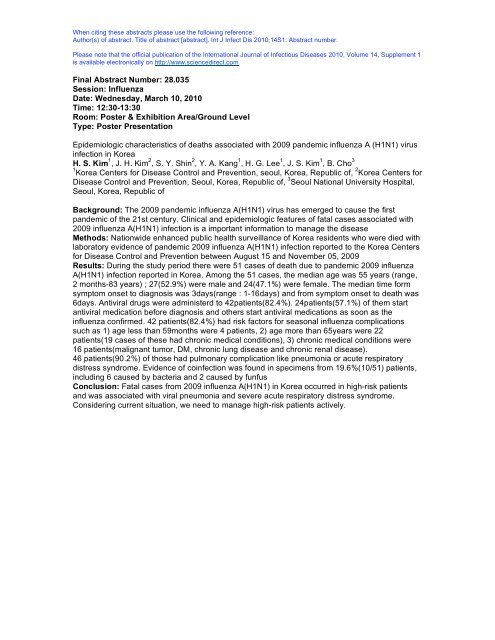14th ICID - Poster Abstracts - International Society for Infectious ...
14th ICID - Poster Abstracts - International Society for Infectious ...
14th ICID - Poster Abstracts - International Society for Infectious ...
Create successful ePaper yourself
Turn your PDF publications into a flip-book with our unique Google optimized e-Paper software.
When citing these abstracts please use the following reference:<br />
Author(s) of abstract. Title of abstract [abstract]. Int J Infect Dis 2010;14S1: Abstract number.<br />
Please note that the official publication of the <strong>International</strong> Journal of <strong>Infectious</strong> Diseases 2010, Volume 14, Supplement 1<br />
is available electronically on http://www.sciencedirect.com<br />
Final Abstract Number: 28.035<br />
Session: Influenza<br />
Date: Wednesday, March 10, 2010<br />
Time: 12:30-13:30<br />
Room: <strong>Poster</strong> & Exhibition Area/Ground Level<br />
Type: <strong>Poster</strong> Presentation<br />
Epidemiologic characteristics of deaths associated with 2009 pandemic influenza A (H1N1) virus<br />
infection in Korea<br />
H. S. Kim 1 , J. H. Kim 2 , S. Y. Shin 2 , Y. A. Kang 1 , H. G. Lee 1 , J. S. Kim 1 , B. Cho 3<br />
1 Korea Centers <strong>for</strong> Disease Control and Prevention, seoul, Korea, Republic of, 2 Korea Centers <strong>for</strong><br />
Disease Control and Prevention, Seoul, Korea, Republic of, 3 Seoul National University Hospital,<br />
Seoul, Korea, Republic of<br />
Background: The 2009 pandemic influenza A(H1N1) virus has emerged to cause the first<br />
pandemic of the 21st century. Clinical and epidemiologic features of fatal cases associated with<br />
2009 influenza A(H1N1) infection is a important in<strong>for</strong>mation to manage the disease<br />
Methods: Nationwide enhanced public health surveillance of Korea residents who were died with<br />
laboratory evidence of pandemic 2009 influenza A(H1N1) infection reported to the Korea Centers<br />
<strong>for</strong> Disease Control and Prevention between August 15 and November 05, 2009<br />
Results: During the study period there were 51 cases of death due to pandemic 2009 influenza<br />
A(H1N1) infection reported in Korea. Among the 51 cases, the median age was 55 years (range,<br />
2 months-83 years) ; 27(52.9%) were male and 24(47.1%) were female. The median time <strong>for</strong>m<br />
symptom onset to diagnosis was 3days(range : 1-16days) and from symptom onset to death was<br />
6days. Antiviral drugs were administerd to 42patients(82.4%). 24patients(57.1%) of them start<br />
antiviral medication be<strong>for</strong>e diagnosis and others start antiviral medications as soon as the<br />
influenza confirmed. 42 patients(82.4%) had risk factors <strong>for</strong> seasonal influenza complications<br />
such as 1) age less than 59months were 4 patients, 2) age more than 65years were 22<br />
patients(19 cases of these had chronic medical conditions), 3) chronic medical conditions were<br />
16 patients(malignant tumor, DM, chronic lung disease and chronic renal disease).<br />
46 patients(90.2%) of those had pulmonary complication like pneumonia or acute respiratory<br />
distress syndrome. Evidence of coinfection was found in specimens from 19.6%(10/51) patients,<br />
including 6 caused by bacteria and 2 caused by funfus<br />
Conclusion: Fatal cases from 2009 influenza A(H1N1) in Korea occurred in high-risk patients<br />
and was associated with viral pneumonia and severe acute respiratory distress syndrome.<br />
Considering current situation, we need to manage high-risk patients actively.
















